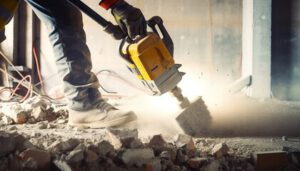Concrete is one of our strongest materials, but like most things, it wears down over time. Rather than replacing it, repair is often the better option.

But a good repair starts with a thorough condition evaluation. This should include destructive and nondestructive inspections, core tests, and chemical and petrographic analysis. For professional assistance, contact Concrete Repair Morgantown WV now!
Concrete cracks in structures are often a sign of deeper problems. They can also be a result of stresses caused by building materials or a changing environment. These cracks can also allow water to penetrate into the building, leading to further damage and deterioration. When deciding on the best repair method, the crack’s type and cause must be evaluated. This will help to minimize economic damage and future deterioration.
Linear dry cracks, sometimes called plastic shrinkage or freeze/thaw cracks, are usually not serious and can be filled with a concrete sealer without affecting the structural integrity of the structure. These cracks are generally hairline in width and do not extend through the entire thickness of the concrete slab. These cracks are often a result of soil conditions and/or moisture content in the ground below the slab.
If you suspect a structural problem, or if the cracks extend through load bearing walls or columns, it is recommended to have a professional evaluate the condition of the structure and suggest repairs. In this case, the cracks may require a more serious repair approach than simply filling with hydraulic cement.
Non-structural cracks, on the other hand, do not endanger the structural integrity of a building and may be repaired with a commercial concrete repair product. It is important to note, however, that cracks that do not receive treatment will grow and deteriorate over time.
To treat these cracks, first chisel out the crack and make sure it is wide enough to accept the new material. Then clean the crack to remove any dust or debris that can act as a bond breaker. Once the crack is clean, stuff foam backer rod into it to create a base to hold the repair material. Use a rod diameter slightly larger than the crack width. Then apply the concrete repair material according to the manufacturer’s instructions.
For wider cracks, epoxy injection and hydrophilic urethane injection are the preferred techniques. These products will extend the life of the crack by sealing it against moisture and other destructive environmental factors. However, they will not strengthen the concrete and should be combined with another method of structural reinforcement.
Voids
The effectiveness of concrete repair depends on the interfacial adhesion between repair materials and substrate. Currently, cement-based repair materials are widely used in the construction industry due to their good compatibility with the existing concrete structure and economical benefit. The most common binders of cement-based repair materials are Portland cement (PC), sulphoaluminate cement (SAC) and magnesium phosphate cement (MPC). Blending materials, such as fly ash, blast furnace slag and silica fume, can also be used to improve the performance of these binders.
However, the interface between the repairing material and concrete is usually a weak zone, which leads to the failure of repair materials in a short time. Consequently, plenty of research is carried out to explore the mechanisms and factors that affect the interfacial adhesion between these two materials.
In this regard, the use of special epoxies or acrylics with a thick consistency is commonly employed in vertical concrete repair. These products are designed to adhere to the existing concrete and stay firmly in place, even when exposed to the elements. Additionally, these types of repair materials are ideal for ceiling or overhead concrete surfaces since they tend to be more difficult to access and work on.
Another type of repair material is alkali-activated material (AAM). AAM is obtained through the alkaline activation of silica and alumina-rich materials, such as metakaolin (MK) and fly ash. When used as a repair material, AAM forms calcium (natrium) silicoaluminate hydrates with the substrate concrete, which enhances the interface adhesion.
Pull-out bond strength testing is a popular method to determine the tensile bond strength of concrete repair materials and the existing substrates. In this test, a steel block is bonded to the sample surface using epoxy glue, and then a vertical pull force is applied until the interface breaks. Split bond strength testing is another method to measure the tensile bond strength of a repair material.
To improve the bond between AAM and concrete structures, a few scholars have suggested the modification of this repair material through the use of organic materials. For example, styrene-butadiene resin-based and acrylic-based polymers were used to modify AAM, which resulted in improved tensile strength and adhesion with the concrete substrate.
Expansion Joints
A concrete slab’s expansion joints are designed to accommodate the natural shifts in environmental temperature that cause concrete structures to expand and contract. These gaps are necessary for the structure to function properly, but they are aesthetically displeasing and should be repaired with weather-resistant concrete expansion joint sealant.
Concrete expansion joints are usually filled with asphalt, but they can be made from other materials like cellular or closed-cell foam, if needed. Typically, the joint material is used to prevent water infiltration, but it’s also designed to protect the concrete from environmental contaminants like petroleum and chemical spills. The type of joint material you choose will depend on the environment and the use of the concrete slab.
The leading reason concrete expansion joints crack and fail is poor material selection and application. It’s important to use a high-quality expansion joint material that is compatible with the concrete it’s paired with and that will withstand the environmental conditions the slab will be exposed to. The material should also be resistant to freezing and thawing, moisture infiltration, and contaminants like oil and fuel that can damage concrete.
To install or repair expansion joints, you will need a good quality caulking gun and a specialized concrete expansion joint sealant. It’s essential to clean the area thoroughly before applying the sealant and to remove any loose or broken concrete from the gap. Once the area has been cleaned, apply the bonding adhesive to the surface of the joint. Let it dry for a few minutes before moving on to the next step.
Apply the concrete expansion joint sealant to the entire surface of the joint. If the concrete has a texture, trowel it to ensure it is evenly spread and to fill any voids. For larger expansion joints, you may need to use a wooden former for reinforcement. When the sealant has cured, remove the former and replace with pre-measured backer rod if necessary.
Professionally designed and repaired expansion joints provide a number of key benefits, including superior safety for employees. They minimize tripping hazards, and they help forklifts roll smoother by reducing the jarring effect of uneven loading on the slab. Another benefit of properly functioning expansion joints is low maintenance, which will save you money in the long run.
Structural Damage
Structural damage in concrete repair involves restoring the strength and integrity of a damaged area. It is important to diagnose the problem properly so that the correct materials and repair techniques can be used. This is because a misdiagnosis could lead to failure of the repaired zone again later. Structural damage in concrete may be caused by a number of factors, including bad weather, cavitation, erosion, abrasion, reinforcement corrosion, chemical assaults, carbonation, fractures, aging, design and construction errors, and loading conditions that are excessive or improper.
The most common structural problems with concrete structures are spalling and debonding of the concrete from the rebar. Oftentimes, this is a sign of major damage to the concrete structure and requires attention from a professional engineer. Other symptoms of structural damage include movement in the floor or walls, cracking that extends through the entire structure, and/or settlement or displacement of joints and corners.
For concrete repairs that require a strong structural bond, epoxy injection is the preferred method. This is a costly process that requires a skilled contractor. It involves injecting an epoxy resin into the cracks, which then bonds to the concrete and forms a monolithic structure. For repairs that do not require a strong structural bond and only need to stop water flow, urethane sealants can be used. They do not form a concrete repair but will stop the water from seeping into the cracks.
A hammer test can also help to identify the extent of concrete damage. When a hammer is struck on the surface, a ringing sound indicates sound concrete while a drummy, hollow or dull sound is indicative of delamination. A visual inspection can also reveal the presence of deep delaminations and disbonding.
The durability of concrete repairs depends on a number of factors, including the physical properties of the repair material, curing procedures, surface preparation and finishing practices, and freeze-thaw durability. A key property to consider is bond strength, which is a function of both the material and application. In order to achieve a high bond strength, it is essential to follow the manufacturer’s recommended curing and finishing techniques.
